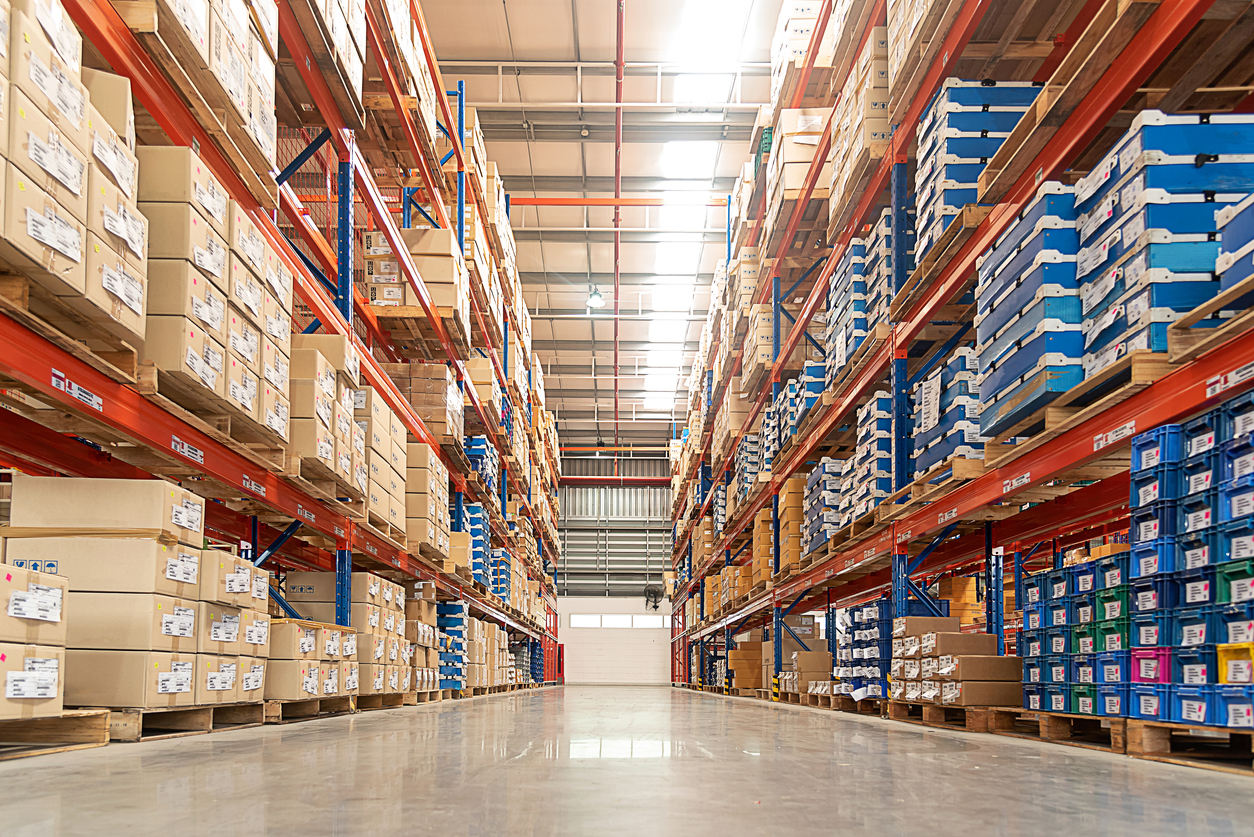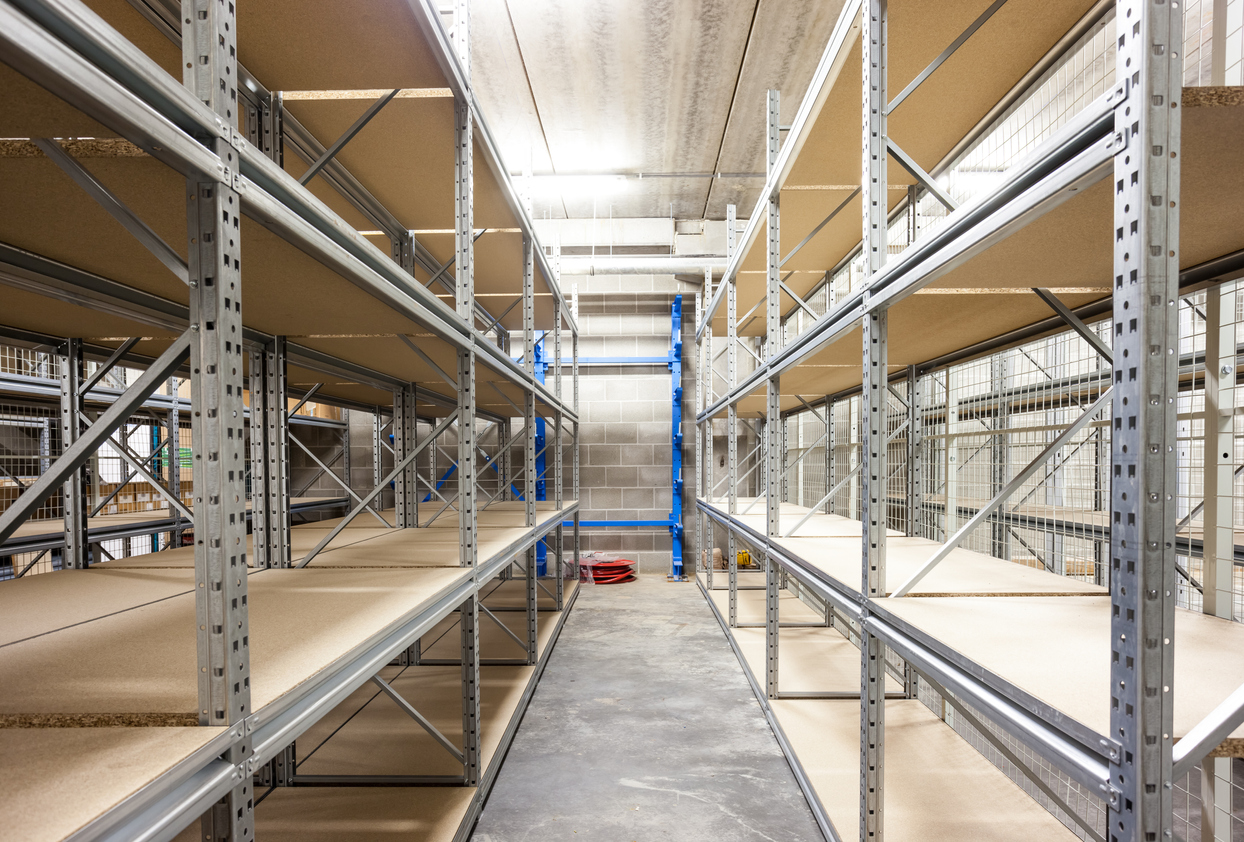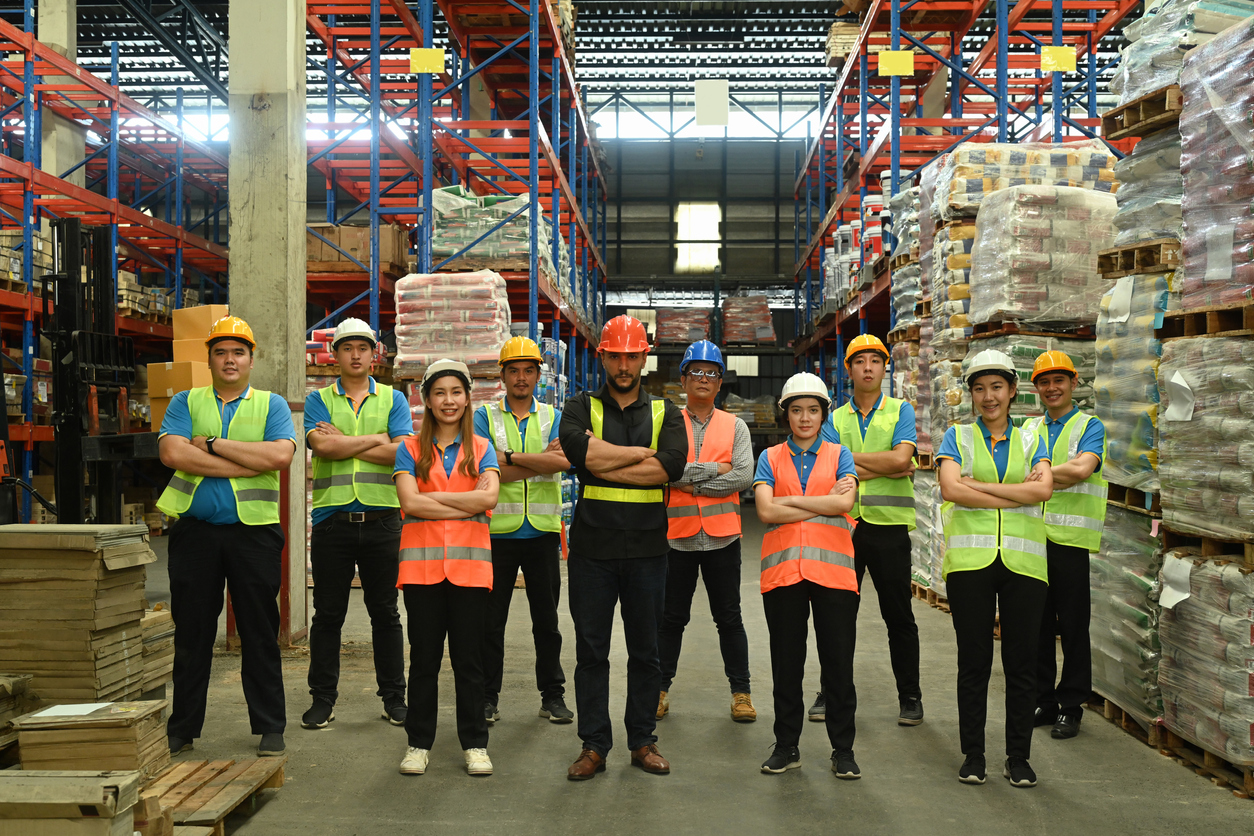

MakMax Plus
Explanation of [12 methods] to improve warehouse operation efficiency|Indicates how to improve layout and work flow lines
2024.01.15

Warehouse operations require efficient business operations, but you are probably struggling with the complexity of your work. Efficiency is the key to increasing productivity and reducing costs. This article details 12 techniques for making warehouse operations more efficient. By streamlining your operations, you will also reduce the workload on your workers and improve overall productivity.
Warehouse Efficiency 1. Organize

Rows of shelves with goods boxes in huge distribution warehouse at industrial storage factory.
Organization in the warehouse is an important first step toward efficiency. Properly storing products and securing temporary storage space are essential for smooth product management. In particular, the introduction of “5S activities” will greatly contribute to improving work efficiency. This activity is also effective in improving quality and costs.
The “5S Activity” consists of the five “S’s” of Seiri (Seiri), Seiton (Seitonin), Seiso (Seiso), Seiketsu (Seiketsu), and Shitsuke (Shitsuke). These methods were originally used in the manufacturing industry, but they can also be very useful in improving the efficiency of warehouse operations. Each “S” has the following meaning Seiri (Sorting) separates necessary items from unnecessary ones. Seiton (Seiton) places things in their proper places. Seisou refers to keeping the work environment clean at all times. Seiketsu (cleanliness) is to make cleaning a habit and set a standard. Finally, Shitsuke (discipline) refers to establishing discipline for the ongoing performance of these activities.
If “5S activities” can take root as a rule in a warehouse, improvements in both efficiency and quality can be expected. Not only will daily operations run more smoothly, but it will also lead to cost reductions and increased productivity in the long run.
Warehouse Efficiency 2. Standardize operations

Asian workers having an architectural meeting
A wide variety of operations are performed in a warehouse, and if each operation employs its own method, there is a risk of inconsistent quality. To solve this problem, manual standardization of efficient work methods is recommended.
The existence of and adherence to manuals encourages standardization of operations. Manuals are especially useful when there is a lot of staff turnover or when training new employees. This will enable both skilled and new staff to maintain the same quality of work, and can be expected to have the effect of increasing the stability of operations.
Standardized business processes are the foundation of efficient operations. This ensures that work in the warehouse is consistent and that each staff member operates in a predictable environment. The result is increased productivity and consistent quality throughout the operation.
Warehouse Efficiency 3. Optimize Warehouse Layout

Warehouse inside isometric composition including manager and workers, forklifts, shelves with goods, unloading cargo vector illustration
Warehouse layout optimization improves operational efficiency and storage volume. The two main types of layouts are the “I-shape” and the “U-shape. The “I-shape” has a linear flow line and is suitable for improving efficiency in areas where space is limited. The “U-shape” layout has the same receiving and shipping areas, allowing workers to move smoothly.
For efficient flow lines, it is important to reduce walking and to place products according to the frequency of shipments. For example, products that are shipped frequently should be placed closer together and products that are shipped infrequently should be placed farther apart. This increases productivity and reduces labor.
Warehouse Efficiency 4. Properly Manage Locations

Young energetic smart Asian business working woman using digital tablet to check stock of goods on shelves for product management in warehouse, Logistics business planning concept with copy space
Location management is an important factor when considering the layout for efficient warehouse operations. This is a method of managing the storage of goods by attaching addresses to them. There are two main methods: fixed location and free location. In fixed location, goods are stored in a fixed location. In free location, goods are stored sequentially in available space.
Product placement should be based on the frequency of shipments and product movement, in addition to product number and category. For example, it is more efficient to place products that are shipped frequently near the exit and those that are shipped infrequently at the back. Layout design should consider not only daily operations, but also work efficiency during peak periods. This will improve the overall efficiency of the warehouse.
Warehouse Efficiency 5. Shorten work flow lines

Worker hands holding tablet on blurred warehouse as background
Shortening work flow lines is another important factor. The efficiency of worker movement, e.g., picking and warehouse entry, is greatly affected by the length of the line of flow. It is desirable to keep lines of flow as short as possible.
The flow lines in the warehouse should be properly arranged in each location for the shortest and smoothest flow possible. This will save time by reducing the distance workers must travel. Shorter lines of flow also reduce worker fatigue, which not only increases efficiency but also improves work safety. Designing efficient flow lines is essential to the overall productivity of a warehouse.
Warehouse Efficiency 6. Maintain the Minimum Number of Inventory Items Needed

Stacked of Package Boxes Loading into Container Truck. Truck Parked Loading at Dock Warehouse. Delivery Service. Shipping Warehouse Logistics. Shipment Freight Truck Transportation.
Inventory management is an important component of warehouse efficiency. Excess inventory creates more space and work than necessary. Shortages, on the other hand, increase additional orders and labor. Maintaining a balanced, minimum required inventory will increase efficiency and reduce costs.
Efficient use of storage space improves the overall efficiency of logistics. In addition, periodic review of inventory and maintenance of the proper number of items is essential to the efficiency of warehouse operations. This allows for the reduction of unnecessary inventory and the securing of necessary inventory, contributing to the smooth operation of overall operations.
Improve warehouse efficiency7. Review storage facilities

empty storage racks in a building with security
Proper selection and placement of storage equipment is key to warehouse efficiency. Converting flat space into storage racks allows for more efficient use of space. In addition to fixed shelving, there are a variety of storage facilities, such as moving racks, that must be selected according to the characteristics of the cargo.
Racks and shelves are ideal for storing smaller items. Medium-weight and lightweight shelving and multi-level racks help efficiently store goods of various sizes. Moving shelves also save aisle space and allow for efficient product placement.
Rental of equipment is also an effective way to accommodate seasonal and demand fluctuations. This allows for flexible expansion or contraction of storage space as needed. Selecting the right storage equipment can improve warehouse space utilization and significantly improve operational efficiency. Selecting efficient storage facilities is one of the key strategies in warehouse operations.
Warehouse Efficiency 8. Choosing the Right Picking Method

Employees are counting products in the warehouse.
Picking is an important part of warehouse operations that has a significant impact on efficiency. There are two primary methods of picking: order picking and total picking.
Order picking is a method of retrieving goods by order. This method is suitable for a large variety of products. Order picking allows for direct shipment after picking, reducing labor.
Total picking, on the other hand, is a method of taking out multiple orders at once. This method is effective when the number of product types is small and the number of shipping destinations is large. While it can shorten the workflow, it may increase the amount of sorting work during shipment.
Which picking method you choose depends on the type of goods, the number of shipping destinations, and your operational situation. Choosing the right method for your company can increase picking efficiency and overall warehouse productivity. Choosing the right picking method is one of the key strategies in improving the efficiency of your warehouse operations.
Warehouse Efficiency 9. Ensure Adequate Work Staff

Group of warehouse worker standing in line with arms crossed together at logistic distribution warehouse. Corporate team concept.
The efficiency of warehouse operations relies heavily on the availability of work staff. Without sufficient manpower, especially at the timing of incoming and outgoing shipments, the speed of operations is affected. Coordination with delivery companies is also essential. The logistics industry is facing a labor shortage, and securing the right staff directly affects the efficiency of operations.
Having a sufficient number of working staff is essential to improving warehouse efficiency. Having a diverse workforce and providing a good working environment will enhance operational efficiency. Staffing and retention is a key component of warehouse operations and an essential strategy for efficient warehouse operations.
Warehouse Efficiency 10. Implement a System

Worker hands holding tablet on blurred warehouse as background
The implementation of an appropriate system is essential to improve the efficiency of warehouse operations. In particular, a Warehouse Management System (WMS) is a tool that can greatly improve operational efficiency, utilizing barcode technology to instantly retrieve information and reduce human error.
Inventory management systems also help to quickly assess inventory levels in the warehouse. Work is performed more quickly and accurately through the use of handheld terminals and barcode technology. These technologies are important factors that increase worker efficiency and improve the quality of operations.
The implementation of the system will not only shorten work hours, but will also greatly contribute to improving quality. This will improve the overall productivity of your warehouse operation and give your business a competitive edge. Selecting and implementing the right system is an important strategy for warehouse operations, as it is the key to improving efficiency and quality.
Warehouse Efficiency 11. Utilize material handling equipment

Warehouse courier cargo shipment, inventory management
Material handling equipment is important equipment that dramatically improves the efficiency of logistics and warehouse operations. Typical examples are forklifts and conveyors. In recent years, advanced technologies such as automated transfer robots have been introduced to automate operations.
These devices are particularly effective in saving labor for time-consuming and labor-intensive tasks. For example, in the assembly and sealing of corrugated boxes, the use of material handling equipment greatly improves work efficiency.
However, it can be difficult for small and medium-sized businesses to afford expensive equipment. Relatively inexpensive equipment such as roller conveyors and hand forks can therefore be useful. Even though these low-cost devices require human operation, the labor reduction benefits are significant, and they may be more suitable than larger equipment under certain circumstances.
When selecting material handling equipment, it is important to consider the products you handle and the nature of your business. Selecting the right equipment can greatly improve the efficiency of warehouse operations. The use of this equipment will contribute to saving time and labor, and improve the productivity of the entire logistics operation.
Warehouse Efficiency 12. Leverage External Resources

Asian businessman and woman handshake after negotiation in manufactory. Attractive industry factory engineer people talking about business deal, merger and acquisition at manufacturing plant warehouse
Improving warehouse efficiency requires a multi-pronged approach, but it can be difficult to do everything in-house. In such cases, utilizing outside resources can be effective. For example, logistics outsourcing can be considered. This makes it possible to outsource some or all of the operations from receiving to shipping.
Using outside resources can reduce overall logistics costs compared to doing everything in-house. This can result in cost savings as well as efficiency gains. The use of external resources is one effective option for increasing the efficiency of warehouse operations. This allows companies to utilize their own resources more effectively and improve logistics efficiency.
summary

Efficient logistics processes in automated warehouses powered by AI, modernization of warehouses and logistics through 6G technology and AI.
Improving the efficiency of warehouse operations requires a multifaceted approach. There are many approaches, including organizing, standardizing operations, selecting picking methods, introducing systems, and using material handling equipment, just to name a few. Let’s review the methods that are not being implemented in your company and start with those that can be introduced.
Another effective approach is to change the warehouse itself. Tent warehouses are attracting attention as a new option. Tent warehouses are constructed by assembling a steel frame and covering it with a sheet membrane, and can be built at low cost and in a short construction period. They are durable and weather-resistant, and are so bright during the day that lighting is unnecessary, improving work efficiency.
A number of forward-thinking manufacturers and companies in the logistics industry have implemented tent warehouses. We encourage you to consider tent warehousing as a means of achieving efficient warehousing operations. If you are interested in tent warehouses, please contact Taiyo Kogyo Corporation, a manufacturer that has been in business for 100 years and has the largest market share in Japan.
への
Any Inquries

What you need to know when building a warehouse
We packed it all in.
Clues to solving the 2024 problem
I want to build a warehouse in an economical way.
Which type of warehouse should we build?
I want to learn the basics of warehouse construction anyway.
I'm concerned about the 2024 problem, but I don't know what to do about it.
Related Articles
- TOP>
- MakMax Plus>
- Explanation of [12 methods] to improve warehouse operation efficiency|Indicates how to improve layout and work flow lines








